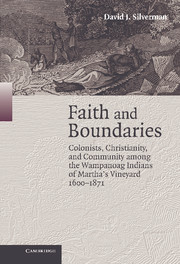 Faith and Boundaries
Faith and Boundaries Book contents
- Frontmatter
- Contents
- Maps, Tables, and Figures
- Abbreviations
- Preface: Do Good Walls Make Good Neighbors?
- Introduction: Epenow's Lessons
- 1 “Here Comes the Englishman”
- 2 To Become All Things to All Men
- 3 The Lord Tests the Righteous
- 4 Deposing the Sachem to Defend the Sachemship
- 5 Leading Values
- 6 The Costs of Debt
- 7 “Newcomers and Strangers”
- Conclusion: Fencing In, Fencing Out
- Appendix A The Population of Martha's Vineyard
- Appendix B A Cross-Comparison of Indian Race Descriptions
- Index
7 - “Newcomers and Strangers”
Published online by Cambridge University Press: 17 December 2010
- Frontmatter
- Contents
- Maps, Tables, and Figures
- Abbreviations
- Preface: Do Good Walls Make Good Neighbors?
- Introduction: Epenow's Lessons
- 1 “Here Comes the Englishman”
- 2 To Become All Things to All Men
- 3 The Lord Tests the Righteous
- 4 Deposing the Sachem to Defend the Sachemship
- 5 Leading Values
- 6 The Costs of Debt
- 7 “Newcomers and Strangers”
- Conclusion: Fencing In, Fencing Out
- Appendix A The Population of Martha's Vineyard
- Appendix B A Cross-Comparison of Indian Race Descriptions
- Index
Summary
Blood boiled at Aquinnah in 1812 when news broke that Zachariah Howwoswee Jr. and Simon Mayhew had submitted a petition to Boston claiming to represent the ten so-called “few remaining Indians of Gayhead.” In it they asserted that the Wampanoags “used to get along quite peaceably and well … [but] now there are so many Negroes and Molattoes got in among us, who are proud, lazy, and do not do right, and hurt us very much, & we cannot help ourselves.” The only way to protect the besieged Natives, Howwoswee and Mayhew contended, was for Massachusetts to place Aquinnah under new guardians, namely themselves. These underhanded men had attempted several land grabs over the last twenty years, only to be defeated at every turn. Now, with Howwoswee sunken in debt and Mayhew overconfident following his election as Chilmark's representative to the state legislature, they hatched this new scheme with the obvious purpose of engrossing Wampanoag territory.
Aquinnah professed shock at the petition's “absurditites,” but no one could have been surprised that race had finally entered the community's politics. Recently, a stark shortage of Indian men had forced growing numbers of Indian women to marry outsiders, a disproportionate number of whom were “blacks” and “mulattoes” since segregationist workplace conditions, laws, and customs grouped Natives with other “people of color.” Although there were scattered examples of Wampanoags pairing with African American slaves stretching back several years, this was the first time open marriages took places in such large numbers, thereby presenting the Indian communities in which the “mixed” couples lived with a host of formidable challenges: Could a non-Indian participate in local government?
- Type
- Chapter
- Information
- Faith and BoundariesColonists, Christianity, and Community among the Wampanoag Indians of Martha's Vineyard, 1600–1871, pp. 223 - 273Publisher: Cambridge University PressPrint publication year: 2005


